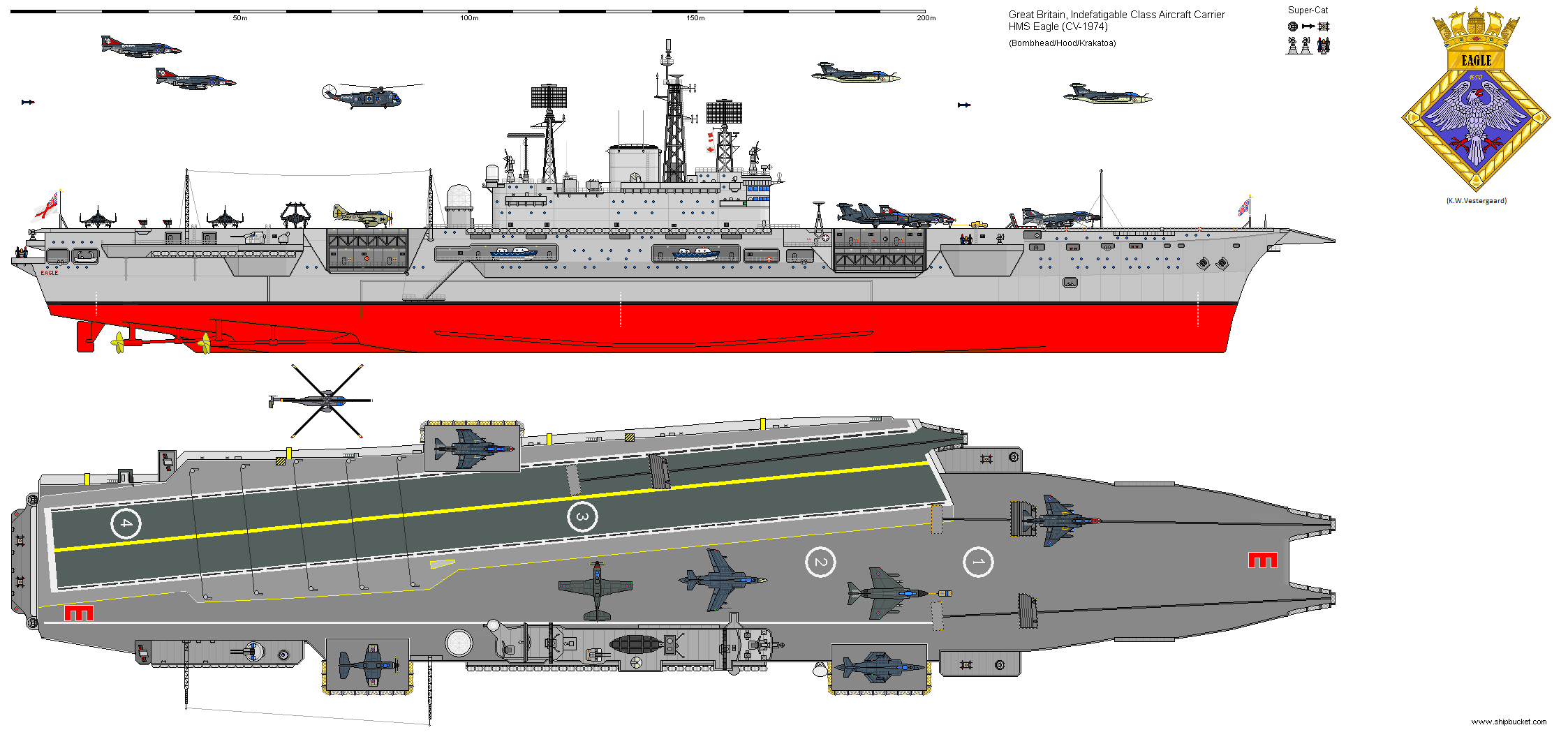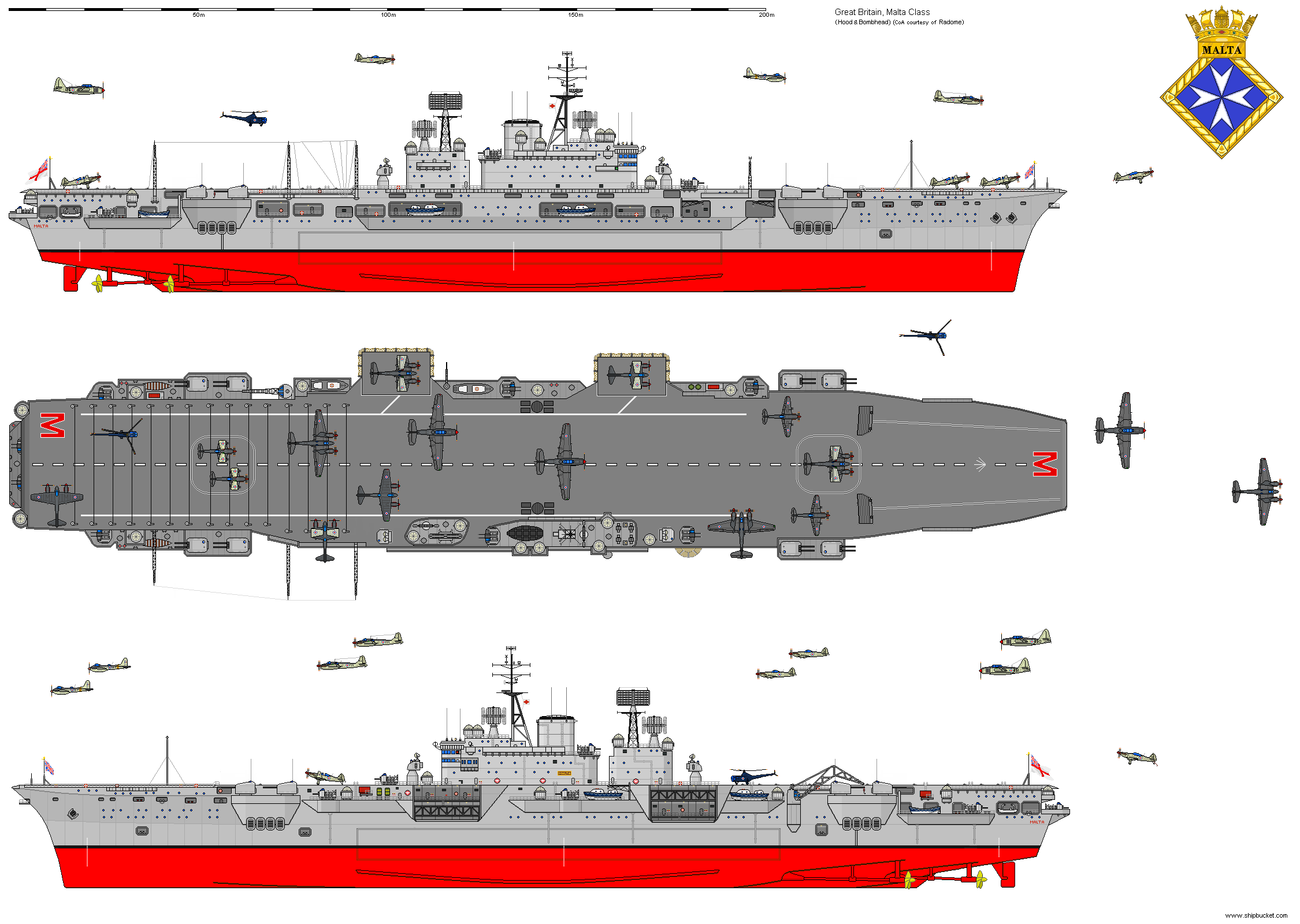After the Improved Ark Royal type, the Illustrious Class of three ships, the war broke out while those ships were still building. In 1940 a larger class of aircraft carrier was ordered. This was the Indefatigable class. Two ships were laid down in 1940 (Implacable and Indefatigable) and completed in 1944, while two more were ordered in 1941 (originally as Malta and Gibraltar, but the names were changed to Ark Royal and Eagle to commemorate lost ships) with completion due for 1945, this date went out to 1946 after the steel shortage of 1941. The last pair were delayed again to take advantage of the new angled deck technology and the necessary upgrades to handle the early jets of the Meteor and Vampire types.

These were the ultimate of British carrier designs. For many years these four ships would be the largest ships built for the Royal Navy. The design included the novel feature of split bridge structures with the after bridge being for the aircraft commander and his staff, the split bridge also helped with directing the airflow overboard rather than swirling over the stern to affect landing. A heavy defensive armament was carried with eight twin 4.5" of the new Mk.V mountings, and 16 of the latest 40mm twin STAAG mountings. No lesser weapons of 20mm or smaller were fitted. The aircraft also were the very latest of the piston engine aircraft available to the RN, with 3 squadrons of Fairey Spearfish, 3 squadrons of Hawker Sea Fury, and 1 1/2 squadrons of De Havilland Sea Hornet aircraft.
RN Aircraft Aboard HMS Implacable 1945.

The first two ships finished their trials and were accepted for service just in time to be transferred to the Pacific Theatre for action against the Japanese. It was there that the new weapons and aircraft more than proved their worth against the Kamikaze menace and in being able to launch many valuable sorties against Japanese targets. Both ships remained undamaged through to the end of the war. On completion of the second pair in 1948, these two ships were taken in hand to receive the same modifications as the later pair. While these ships were under refit, the second pair fought in the Korean War.
1950 is about the limit of my knowledge of ship fittings. I would like to see these ships have a thirty-five year service life for the early pair and 40 year service life for the later pair. If some of you great guys and girls who have more knowledge of this later era could give me some pointers as to when the major updates to the ships should be drawn for e.g. rebuild required to handle Phantoms, mirror landing sights and other innovative equipment and introduction of major RADAR advances. Both pairs would go through a continual cycle of refits for updated systems which once finished the other pair might then be required to go through another refit with the then even newer systems. This would give the UK four ships through to about 1980, then two ships to 1990.
The four Indefatigable class were completed in two pairs. Implacable and Indefatigable were completed in late 1944, early 1945. The Eagle and Ark Royal (named for vessels lost in WW2) were originally to be completed in 1946, but due to the steel shortage of 1941 and revisions of the plans to add in all the latest features it was not until 1948-49 that they began their trials, finally being commissioned into the Royal Navy in 1949-50. The two pairs were hardly ever in commission at the same time. Lengthy refits to update electronics, angled decks, strengthen ship fittings to take ever larger and heavier aircraft. All took time and money. Some of the refits were shortened and the incremental list of things to do would have to wait till next time. Eagle and Ark Royal fought in the Korean war while the double 'I's were in having their angle decks fitted. The double 'I's were eventually decommissioned in 1975-77, the E & AR lasting till 1990, supposedly till the completion of the CVA01 type.
The drawing below pictures Eagle (and Ark Royal) after its 1970-74 refit to be able to operate the Phantom II aircraft. The main armament is four of the new Super-Cat (Supersonic Sea Cat) launchers and control systems. Legacy equipment in the shape of one twin 3"/70 and twin mkV 40mm mountings. This equipment was left as it would have been just as expensive to remove it as it was to leave it in place. It also came in handy for training purposes. With such a large crew, these ships rarely sailed fully manned and were used regularly to train cadets.

With these two ships in commission through the 1980's, were the Argentinians likely to attack the Falkands?
.jpg)
